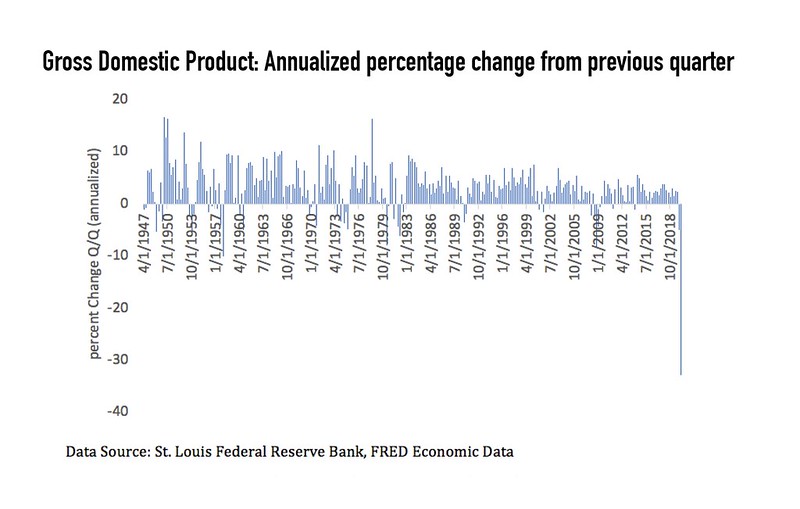July 31, 2020
2nd quarter Gross Domestic Product drops
By Mary Hightower
U of A System Division of Agriculture
Fast facts:
- COVID climate causes historic drop in Gross Domestic Product
- GDP declines more than 9 percent from first quarter
- Third quarter figures may reflect reopening
(597 words)
(Download this story in MS Word format here.)
FAYETTEVILLE, Ark. — A fall off in consumer spending is driving a major drop in the second quarter estimate of the nation’s gross domestic product, according to an analysis released Thursday by the University of Arkansas System Division of Agriculture.
“The second quarter estimate of gross domestic product is arguably the most comprehensive look yet at the impact of COVID-19 and the response to on the nation’s economy,” said John Anderson, head of the agricultural economics and agribusiness department of the Division of Agriculture and the Dale Bumpers College of Agricultural Food and Life Sciences. “Not surprisingly, that impact has been severely negative.”
Anderson authored the report. The update is part of an ongoing analysis from the Division of Agriculture, examining the economic impacts of the COVID-19 pandemic on agriculture and other aspects of society in the United States.
Gross domestic product is the value of all goods and services produced in the United States. It is the sum of four major categories of spending: consumer spending on goods and services, government spending and investment, private investment, and net exports.
Consumer spending dropped $1.32 billion between the first and second quarters of 2020.
“Personal consumption expenditures fell for both goods and services, but the decline was far more significant in services,” Anderson said. “Total spending on services fell by a little over 13 percent from the first to the second quarter.
Health care spending declines
“The largest declines were in spending on health care, food services and accommodations, and recreation services,” Anderson said.
“It is mildly ironic that one of the largest overall declines in spending during a pandemic occurred with respect to health care,” he said. “That demonstrates the extent to which non-COVID health services were displaced by COVID-19, either directly because of facility shutdowns or indirectly because people avoided health care facilities for fear of COVID exposure.”
Spending on goods was only down about 3 percent, and that was due almost entirely to a decline in spending on non-durable goods. Spending on durable goods, such as household appliances, was down by less than half-a-percent in the second quarter.
The non-durable goods posting the largest declines during the quarter were clothing and footwear, gasoline, and food.
“Again, given the massive runs on grocery stores during the height of the pandemic, it may seem odd that spending on food went down at all,” Anderson said. “Note, though, that GDP figures account for value and not quantity. Much of the stockpiling that occurred was focused on staple items, which tend to be relatively lower-valued items.”
Savings up
Consumers are still squirreling away their money. The Bureau of Economic Analysis update on personal income and expenditures that came out this week found that personal income fell in June for the second straight month. Despite the decline, “the personal savings rate for June came in at 19 percent,” he said. “This is a historically high rate of savings, and it suggests that consumers are still engaging in considerable precautionary savings.”
Third quarter expectations
Many state restrictions on businesses began to ease in late-May or early-June.
With that in mind, “third quarter GDP figures will reflect a more economically active time period and should be considerably improved from the second quarter,” Anderson said. “Still, real recovery will require a return of consumer confidence that appears to yet be lacking, particularly as COVID-19 continues to spread actively in many parts of the country, including in Arkansas.”
The GDP report is here:
https://www.uaex.uada.edu/life-skills-wellness/health/covid19/7-30-2020-COVID19-GDP_.docx
The personal consumption and expenditures report is here:
To learn more about extension programs in Arkansas, contact your local Cooperative Extension Service agent or visit www.uaex.uada.edu. Follow us on Twitter at @UAEX_edu.
About the Division of Agriculture
The University of Arkansas System Division of Agriculture’s mission is to strengthen agriculture, communities, and families by connecting trusted research to the adoption of best practices. Through the Agricultural Experiment Station and the Cooperative Extension Service, the Division of Agriculture conducts research and extension work within the nation’s historic land grant education system.
The Division of Agriculture is one of 20 entities within the University of Arkansas System. It has offices in all 75 counties in Arkansas and faculty on five system campuses.
Pursuant to 7 CFR § 15.3, the University of Arkansas System Division of Agriculture offers all its Extension and Research programs and services (including employment) without regard to race, color, sex, national origin, religion, age, disability, marital or veteran status, genetic information, sexual preference, pregnancy or any other legally protected status, and is an equal opportunity institution.
# # #
Media Contact: Mary Hightower
Chief Communications Officer
University of Arkansas System Division of Agriculture
mhightower@uada.edu
501-671-2006
